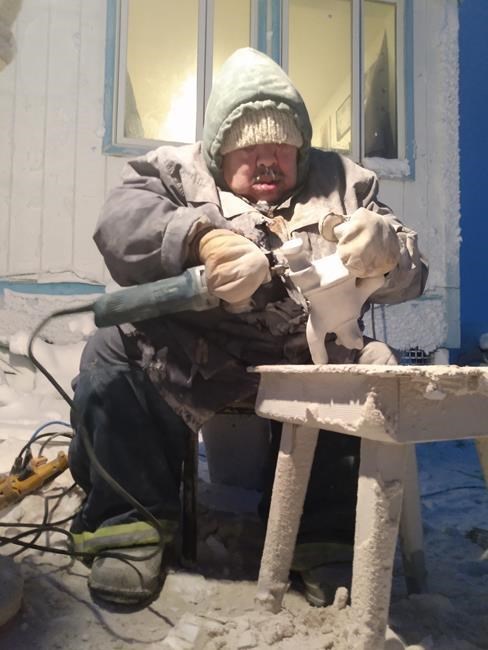GJOA HAVEN, Nunavut — A metallic shrill rings out over the Arctic Ocean on the shores of Gjoa Haven in western Nunavut.
It's the sound of Leo Uttaq's die grinder, a tool he uses to sand down a piece of soapstone, coating himself in grey dust from head to toe.
Uttaq's carving workshop consists of a metal folding chair and a small wooden table set up outside his home in the early October snow.
The longtime carver has balanced a huge piece of soapstone on the table, the bottom part of it carved into what looks like a body with four limbs.
"I'm not sure what it will be yet. Could be a bear, could be a person," Uttaq said.
The hamlet of about 1,300 people, nestled near the entrance to the Northwest Passage, is known for its carvers. Uttaq is one of the most well-known.
His work has appeared in the Museum of Cultural History in Norway and sells in galleries across Canada.
Uttaq grew up in nearby Taloyoak and learned to carve from his father at eight years old. It's a skill that he has passed down to his son, Louie Uttaq.
Louie Uttaq, who is 26 and lives with his young family and his father, said he started carving when he was 12. He hasn't stopped since.
"It clears my mind. It’s like making pretty much something out of nothing," said the younger Uttaq.
He said he remembers his first carving, a seal, which took him about six hours to make.
"I'm still learning now. You never stop learning," he said.
An RCMP officer in the community recently asked him to carve a cribbage board, he said, something he creates with ease now.
Like other carvers in the community, the Uttaqs get soapstone through a program with the hamlet. Residents are paid to go out and collect the stone.
Louie Uttaq said his favourite piece to make is a narwhal, because of the precision needed to make the tiny, thin soapstone tusk.
"It's so hard not to break it, but I'm getting better at it."
He said he can count about nine carvers working today in Gjoa Haven, but he thinks there might be more.
Gjoa Haven's carvings traditionally take the shape of shamans and spirits, often with open mouths and contorted facial expressions.
Jennifer Ullulaq, the manager of Gjoa Haven's Heritage Centre, said the style is unique to carvers from Gjoa Haven and Taloyoak.
"My grandfather, he started making these weird faces into carvings, like spiritual faces," Ullulaq said.
"The stories that they learned through our history about Shamanism — it also inspired their artwork."
Ullulaq comes from a long line of artists from western Nunavut. Her grandfather, Judas Ullulaq, started carving shaman-like faces from whale bones in the 1960s.
"As artists, I think most of our inspiration comes from our family," she said.
In addition to the hamlet's carvers, there are also seamstresses who make parkas and sealskin mitts. Several Gjoa Haven residents also make traditional felt tapestries or wall hangings. The heritage centre regularly buys art from residents at an agreed upon price, Ullulaq said.
“Most people that sell their arts and crafts here, they’re unemployed. This really helps with their income."
Most of Gjoa Haven's original artists are long gone. Passing on traditional knowledge of carving and sewing is urgent and necessary to support the community's next generation of artists, Ullulaq said.
The heritage centre holds workshops for youth on how to do things like sew parkas and build traditional sleds.
But Ullulaq wants to do more.
"We want more youth involved. We want to continue to keep our heritage strong," she said.
This report by The Canadian Press was first published Dec. 15, 2021.
___
This story was produced with the financial assistance of the Facebook and Canadian Press News Fellowship.
Emma Tranter, The Canadian Press



